Physical Address
304 North Cardinal St.
Dorchester Center, MA 02124
Thoracic
Midline posterior thoracic approach
Posterolateral thoracic approaches
Transpedicular
Costotransversectomy
Lateral extracavitary
Lumbar
Midline posterior lumbar approach
Paraspinal lumbar approach
Specific surgical approaches for lumbar interbody fusion
Posterior lumbar interbody approach
Transforaminal lumbar interbody approach
Posterior surgical approaches are the most common surgical approaches used by spine surgeons due to their extensile nature, which enables surgical exposure from T1 to the sacrum and ilium. Advantages of posterior surgical approaches include direct visualization of posterior spinal structures including spinous processes, laminae, pars interarticularis, facet joints, and transverse processes, as well as the ability to simultaneously access anterior spinal column structures through a single surgical incision. Disadvantages of a posterior approach include muscle injury, blood loss, and surgical site pain.
Patients are positioned prone on a radiolucent operative frame or spine-specific surgery table for posterior approaches to the thoracic and lumbar spine. An exception is the use of a lateral decubitus position during simultaneous anterior and posterior surgical procedures. When surgery includes spinal instrumentation and fusion of the lumbar region, patients are positioned with the hips and thighs in an extended position to preserve and enhance lumbar lordosis. During posterior lumbar spinal decompression procedures, reduction of lumbar lordosis by positioning the hips in a flexed position may be used to facilitate access to the lumbar spinal canal by increasing the distance between the spinous processes and lamina. However, as patients with lumbar spinal stenosis are most symptomatic in an extended posture, the patient’s position on the operating table is a factor to consider when determining the extent of lumbar neural decompression.
Incise the skin and subcutaneous tissues with a scalpel
Place Weitlander and cerebellar retractors to tamponade superficial bleeding by exerting tension on surrounding tissues.
Electrocautery dissection is carried out down to the level of the spinous processes.
Cobb elevators and electrocautery are used to elevate the paraspinous muscles from the lamina at the level(s) requiring exposure.
Dissection is continued laterally to expose the pars interarticularis and medial aspect of the facet joints without disrupting the facet joint capsules. This provides sufficient exposure for discectomy and laminectomy procedures.
If an intertransverse fusion is planned, Cobb elevators and electrocautery are used to elevate the paraspinous muscles lateral to the facet joints to expose the transverse processes on each side for decortication and grafting. The facet joints are excised and prepared for fusion. Care is taken to preserve the soft tissue structures (interspinous ligaments, supraspinous ligaments, and facet capsules) at the transition between fused and nonfused levels.
Hemostasis is maintained by coagulating bleeding points with electrocautery and packing with surgical sponges ( Figs. 27.1 and 27.2 ).
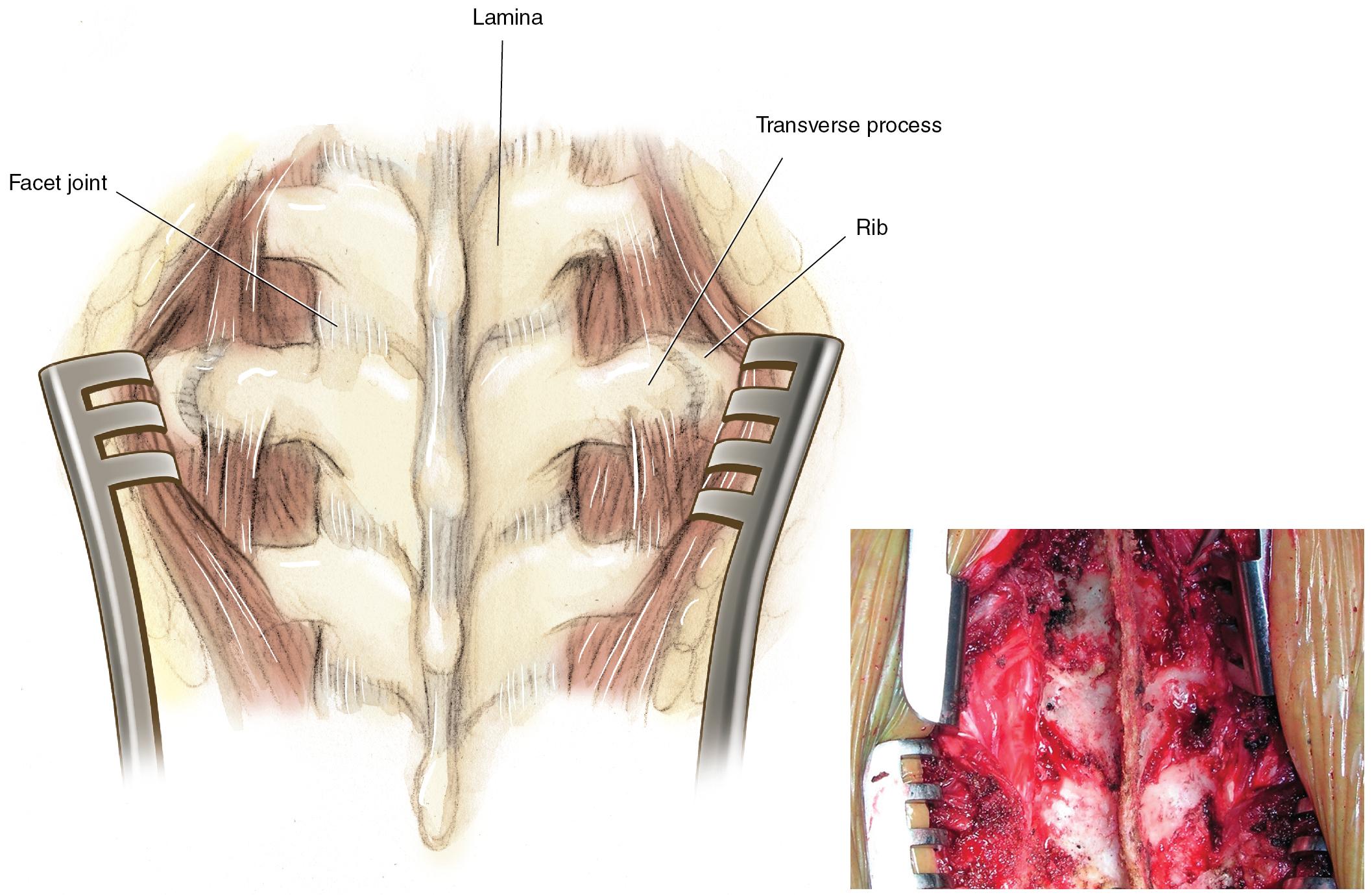
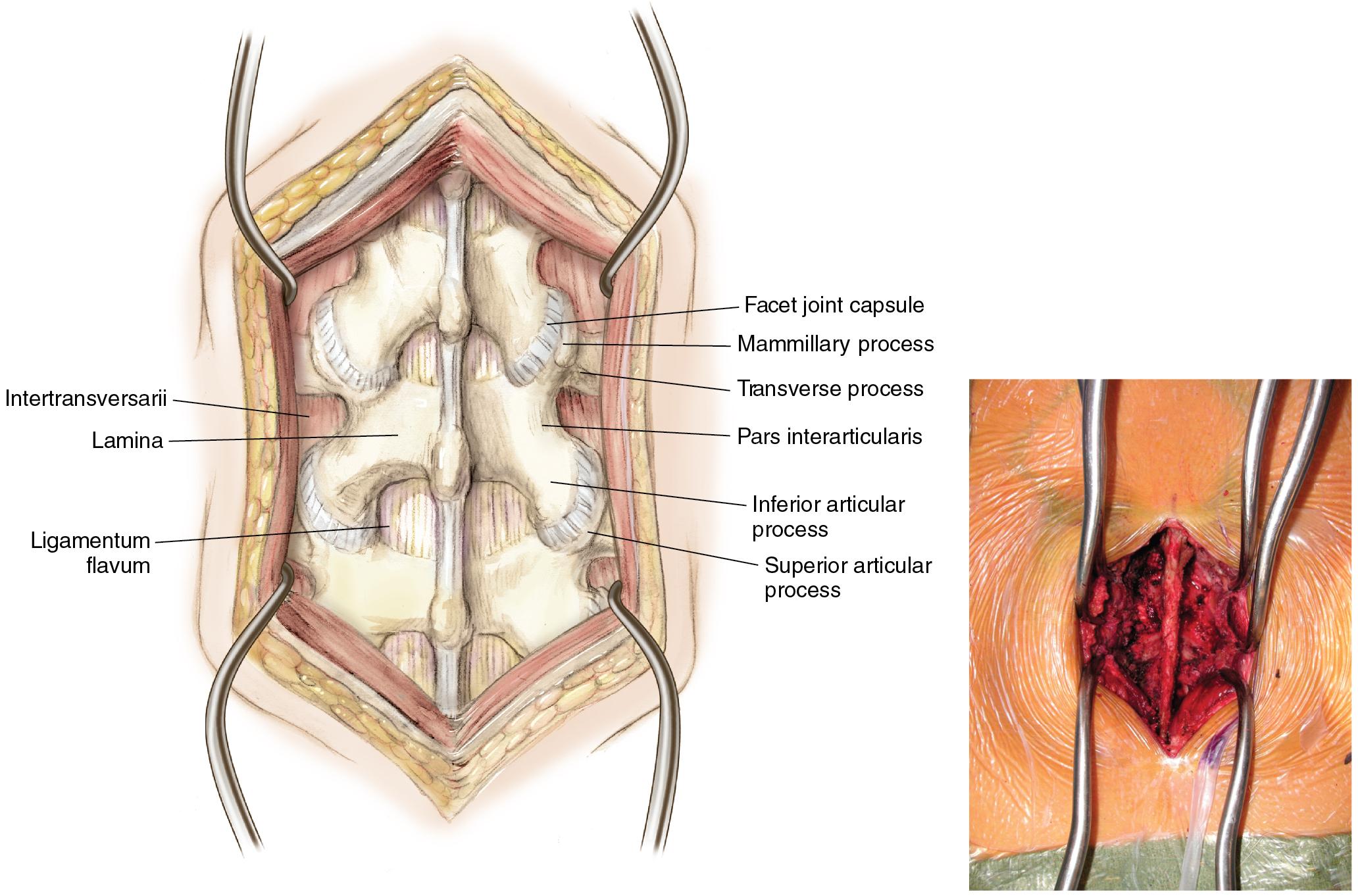
The arterial blood supply of the posterior thoracic and lumbar spine is consistent at each spinal level ( Fig. 27.3 ). Arteries are encountered at the lateral border of the pars interarticularis, upper medial border of the transverse process, and intertransverse region. Sacral arteries exit from the dorsal sacral foramen. The superior gluteal artery enters the gluteal musculature and may be encountered during iliac crest bone grafting.
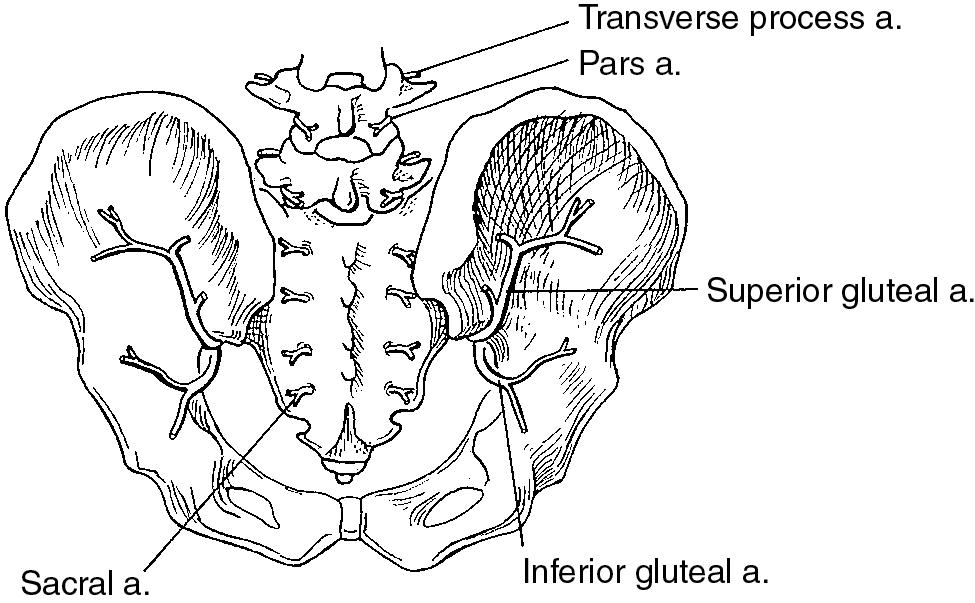
A combination of methods is used to guide exposure of correct anatomic levels:
Preoperative radiographs are reviewed to determine bony landmarks and presence of anatomic variants that may affect numbering of spinal levels (i.e., altered number of rib-bearing thoracic vertebrae, lumbarized or sacralized vertebrae) to plan for surgery.
Intraoperative osseous landmarks are referenced: C7 (vertebra prominens), T8 (inferomedial angle of the scapula), T12 (most distal palpable rib), L4–L5 (superior lateral edge of ilium).
An intraoperative radiograph with a metallic marker at the level of exposure is obtained to confirm exposure of the appropriate spinal level. A permanent copy should be made to document the correct level of exposure for every procedure.
Spinal pathologies that involve the posterior osseous structures or the posterior aspect of the spinal cord are appropriate for treatment using a laminectomy approach. Examples include thoracic spinal stenosis secondary to ligamentum flavum hypertrophy or tumors involving the dorsal aspect of the spinal cord. An isolated laminectomy approach is not indicated for treatment of spinal pathologies anterior or lateral to the thoracic spinal cord due to risks of neurologic injury and spinal destabilization ( Fig. 27.4 ).
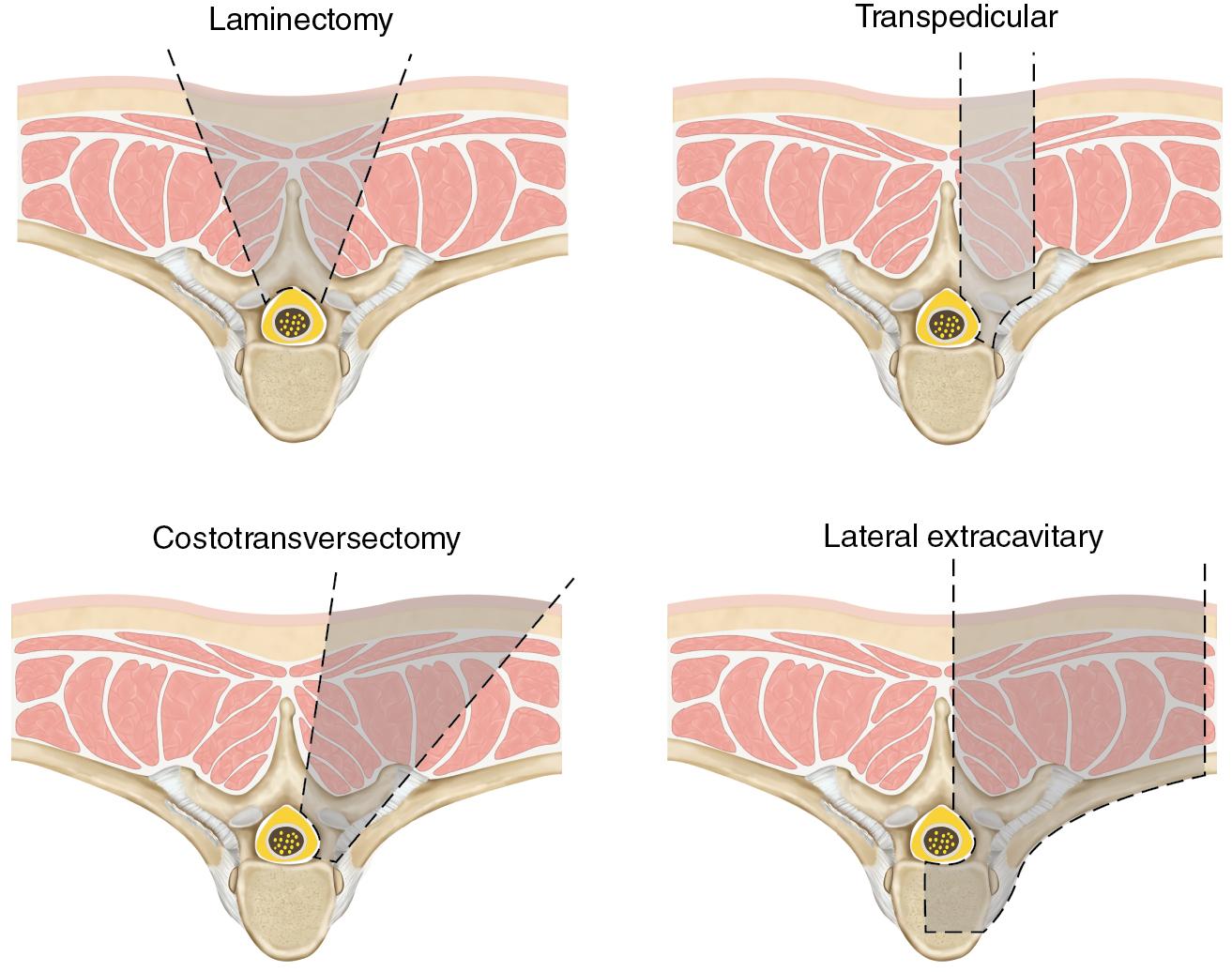
After the spine is exposed by a posterior midline approach, the thoracic pedicle can be used as a pathway to access anterior spinal column pathology. This approach is an option for excision of noncalcified disc herniations located lateral to the spinal cord. The facet joint at the level and side of the disc herniation is resected. The superior aspect of the pedicle below the herniation is removed with a motorized burr. Sufficient working room is created for the removal of disc material. Limited visualization of the anterior aspect of the spinal cord is provided by this approach. A transpedicular approach is also useful for obtaining a vertebral body biopsy (see Fig. 27.4 ).
A rongeur or power burr is used to remove the outer bony cortex and expose the entry site to the pedicle. The entry point for thoracic pedicle is located lateral to the midpoint of the superior articular process. The exact location of the pedicle at each thoracic level varies slightly in relation to the transverse process and the lateral border of the pars interarticularis. At the upper and lower extent of the thoracic spine (T1, T2, and T12), the entrance to the pedicle aligns with the midline of the transverse process. In the midthoracic spine (T7, T8, and T9), the entrance to the pedicle overlies the upper margin of the transverse process.
The lumbar pedicle is located at the intersection of two lines. The vertical line passes along the lateral aspect of the superior articular process and passes lateral to the pars interarticularis. The horizontal line passes through the middle of the transverse process, where it joins the superior articular process.
A costotransversectomy approach is a posterolateral approach to the thoracic spine originally developed for drainage of tuberculous abscesses. It provides unilateral access to the posterior spinal elements, lateral aspect of the vertebral body, and limited access to the anterior aspect of the spinal canal without the need to enter the thoracic cavity (see Fig. 27.4 ). This surgical approach includes resection of the posteromedial portion of the rib and transverse process. The nerve root may be sacrificed proximal to the dorsal root ganglion to facilitate exposure. When extensive vertebral body resection is required, this approach can be performed bilaterally or combined with a transpedicular approach and posterior spinal instrumentation. The costotransversectomy approach can be used for excision of lateral and paracentral thoracic disc herniations and for placement of an anterior column bone graft or fusion cage. A chest tube may be required with this approach if the pleural cavity is inadvertently entered.
A lateral extracavitary approach is a posterolateral extrapleural approach to the thoracic spine and thoracolumbar junction (see Fig. 27.4 ). It provides greater exposure of the anterior spinal column and anterior aspect of the spinal canal than is achieved with a costotransversectomy. This approach involves removal of portions of the rib, costotransverse joint, facet, and pedicle at the operative level. The exposure achieved is sufficient to permit the excision of central disc herniations, corpectomy, and placement of an anterior strut graft or fusion cage. This approach is generally performed in combination with posterior spinal instrumentation and fusion as it creates significant spinal instability. When this approach is used above T4, mobilization of the scapula improves visualization of the vertebral body.
The paraspinal (Wiltse) approach is a posterolateral approach to the lumbar region ( Fig. 27.5 ). This surgical approach utilizes the interval between the multifidus and longissimus muscles. The lumbodorsal fascia is incised two fingerbreadths lateral to the midline. Blunt dissection or tubular dilators are used to expose the facet joint and interlaminar space. This approach provides direct access for the removal of disc herniations and decompression of spinal stenosis located in the extraforaminal zone without the need to resect the pars interarticularis or facet complex. This approach can also be used for placement of pedicle screw instrumentation and for performing lumbar intertransverse fusions. Unilateral resection of the facet complex provides a surgical corridor for direct access to the intervertebral disc for interbody fusion.
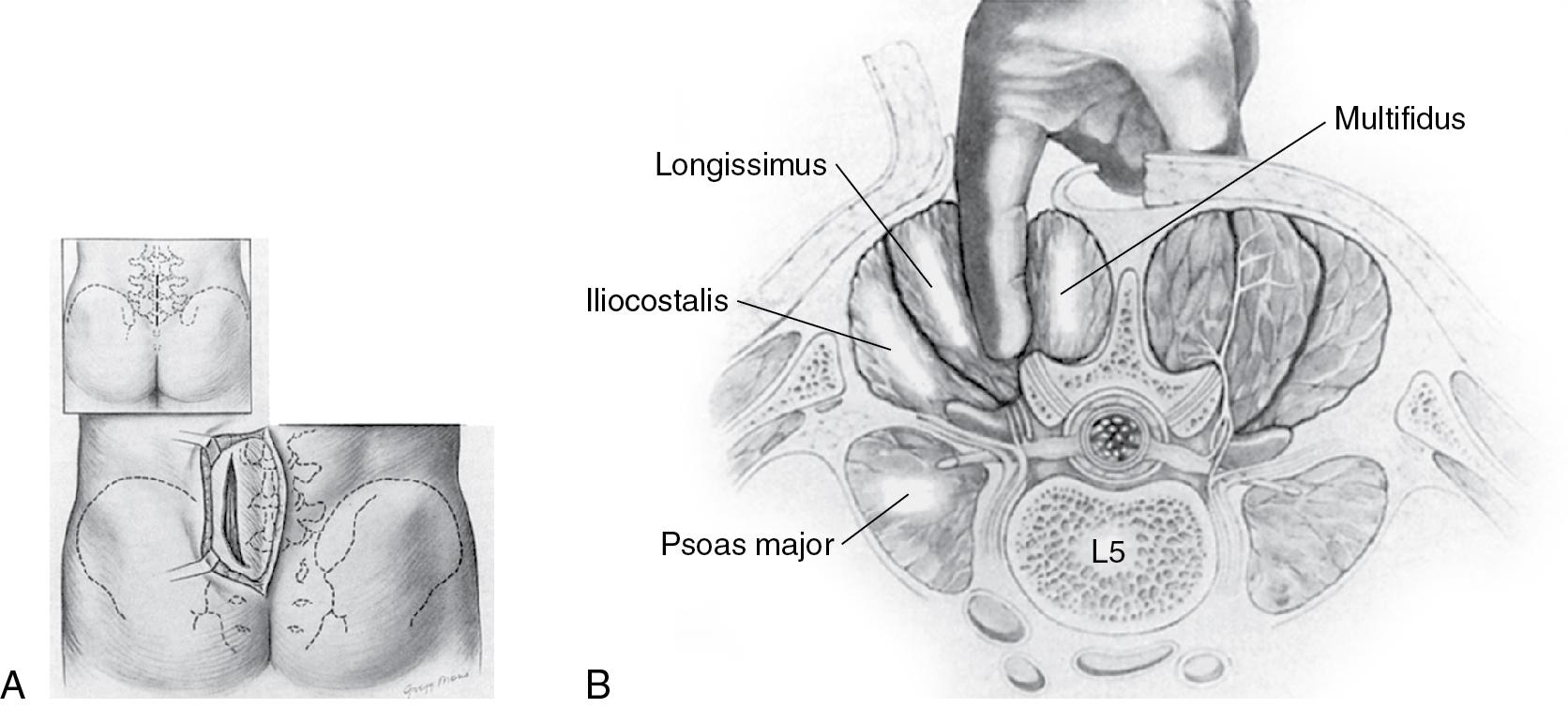
Posterior lumbar interbody fusion (PLIF) refers to a surgical fusion performed by placing structural bone grafts or intervertebral body fusion devices into a lumbar disc space from a midline posterior surgical approach. Retraction of the dural sac and nerve roots are required to prepare the disc space and insert the interbody devices. Procedural steps include laminectomy, bilateral facetectomy, discectomy, restoration of disc space height, and decortication of the vertebral endplates. One interbody device is generally placed on each side of the disc space, and posterior pedicle instrumentation is used to stabilize the spinal segment ( Fig. 27.6 ).
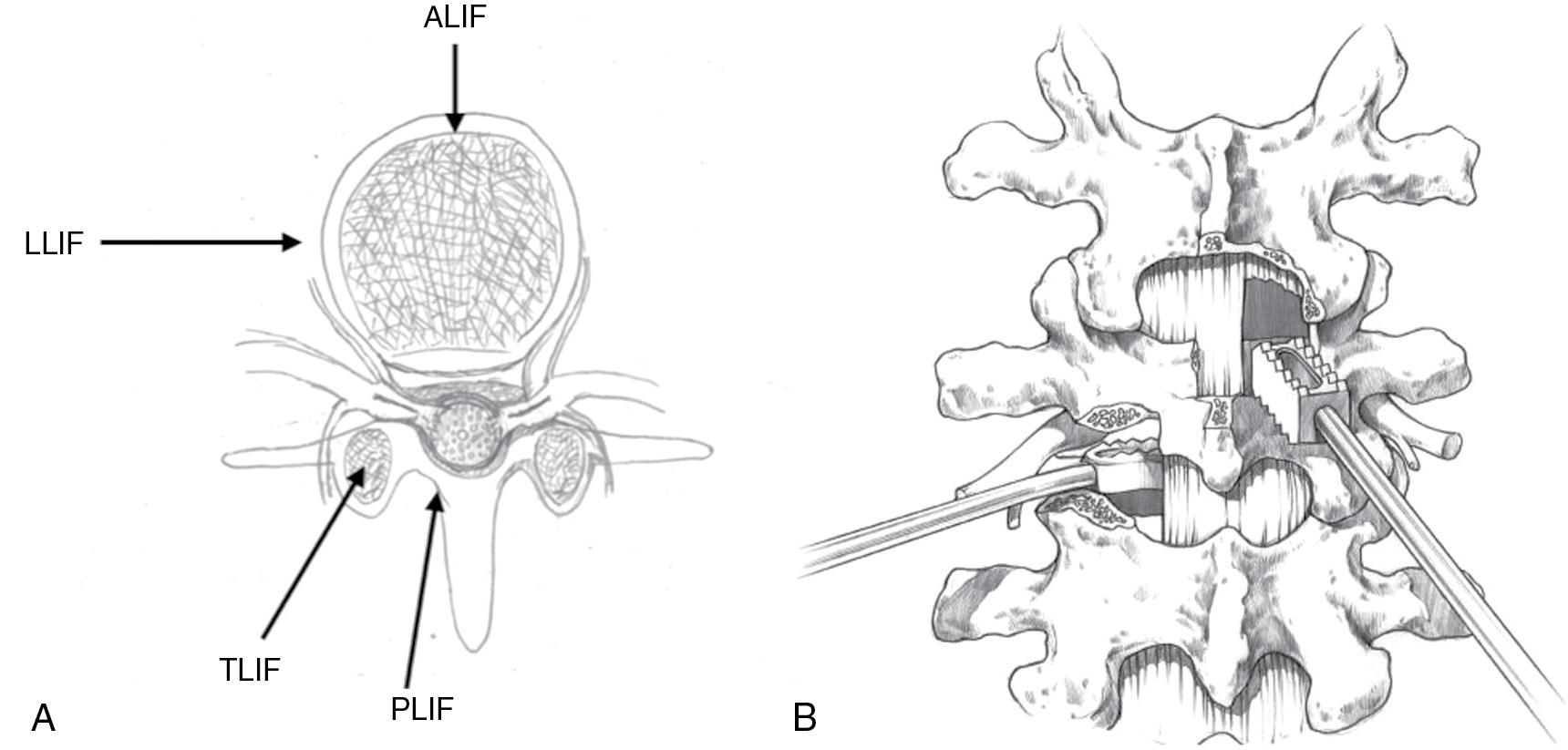
Become a Clinical Tree membership for Full access and enjoy Unlimited articles
If you are a member. Log in here